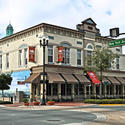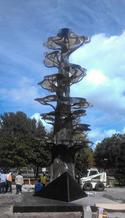The college town, one of America’s most appealing and unique features, grew out of the Age of Reason, and the concept of a regional, liberal-arts college nurtured by a small town has been intertwined with American history. Today, with enrollment dropping, the small, private college seems to be going the same way as the typewriter, the newspaper and the independent bookstore. While some colleges struggle to survive, the institution of the college town lives in suspended animation, ready to support whatever form its major employer may take. read more »
Florida
Florida: When Density is Destructive
Brick streets, mature old oaks, and a sense of history imbue Winter Park, Florida with a sense of place that is the envy of many small cities and towns. The tony Park Avenue brings shoppers and visitors, who soak up its ambience and enjoy the street life of this quaint southern town. On the east side, bounded by blue lakes, lie gentrified historical mansions, while the west side is a neighborhood of smaller, affordable homes with multigenerational Winter Parkers. read more »
- Login to post comments
Florida: How Fine Art Became Local
Fine art resides not only in the cosmopolitan cities. It lived, as we saw in the recent movie “The Monument Men”, in the many villages of Europe. Right now, we are seeing it living on the periphery of Orlando, Florida. read more »
- Login to post comments
The Reinvention of Sanford, Florida
Sanford, Florida was in the midst of reinventing itself. Then the calamity of Trayvon Martin’s violent death turned this sleepy Florida town into a poster child for everything that's wrong with the state. Now that the media frenzy has moved on to other troughs, the residents must sweep up the mess. As is often the case, compassion and healing have been operating quietly in the background. read more »
- Login to post comments
The Private Business of Public Art
Like many cities coming out of the downturn, Orlando is jonesing for a recovery. To promote a sense of new prosperity, City Hall leaders recently added eight works of art to its downtown core, amidst much fanfare. Before we start whistling “Happy Days Are Here Again,” however, we would do well to examine the circumstances of this renewed interest in public art. Its surprising return was trumpeted as a new way to enrich the city and benefit its residents; many, including this author, applauded the effort. This has certainly happened. But has the result been a barrier, as much as a connection, to its citizenry? read more »
- Login to post comments
Orlando, Florida: East End Market & the New Localism
Getting meat and potatoes from the farm to the table depends upon a smooth, even flow. The smaller farmers' markets are mostly absent in the city these days, with a few vestigial exceptions: Reading Market in Philadelphia, Pike Place in Seattle, and Greenmarket in Manhattan, to name a few. Now, East End Market on Corrine Drive in Orlando has taken its place alongside these venerable exchanges. read more »
- Login to post comments
Why Trayvon Martin Defines Sanford, Florida
For other rural cities in America, Sanford, Florida, home of the George Zimmerman trial, is useful as a cautionary tale: Define yourself now, before an incident like the shooting of Trayvon Martin defines you.
All of Florida is once again in an uncomfortable position, this time with the Zimmerman verdict. The state has by now earned a solid last-place position in its contribution to America’s culture. Its poor history was topped by its performance in the 2000 presidential election, but it includes lurid crimes going back well over a century. Most Florida residents quickly change read more »
Florida's Pinellas County: Growth Gone Wild
In the seventeen years since my last visit, Florida's Pinellas County hasn't much changed. It's still a low-grade carpet of commercial junk space from coast to coast, and the edges - where the value really lies - aren't very different than they were in the 1990s. There's more, but not better. A county that has consistently avoided growth regulation, Pinellas could have been a model for cooperative public/private real estate development, unimpeded by pesky government regulations. Instead, it is a living example of the atrocious results when leaders focus on quantity, not quality. read more »
How We Should Navigate the Florida Archipelago
Leafy, timeless rural routes and monotonous, flat highways have characterized Florida’s network of state roads since the early 20th century. Vacationers in the Sunshine State either stick to the interstates – often a hot, frustrating parking lot – or consign themselves to the stop-and-go, confusing local roads. Future Corridors, the state’s vision of a future, integrated road network, is set to finish its conceptual phase this year, and promises to radically revamp the state’s road system. read more »
Urban Housing: A Master Plan for the Few
How we, as a nation, find bounty and beauty in the future depends upon how we react to two trends emerging from the recent difficult period in American urbanism. The first of these trends is the increasing lack of affordability in mainstream urban America, with the costs of maintaining a middle-class lifestyle at a level where distinct have/have-not lines are now drawn. The second is the increasing authoritarianism in mainstream urban America, where decisions about how our cities function are guided by a new array of authority figures that represent the common good. read more »





















